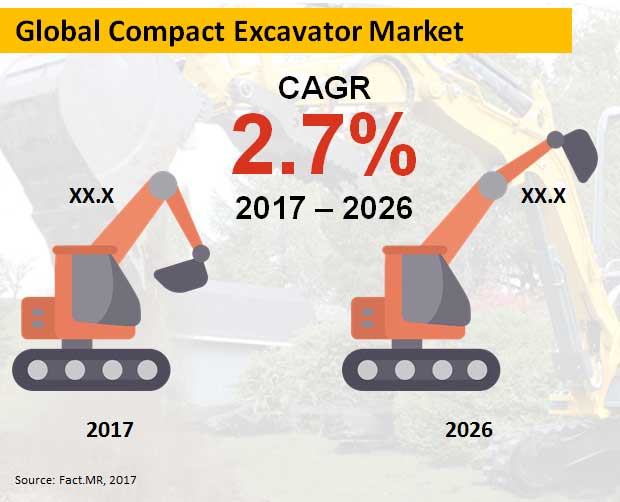During the forecast period, 2017-2026, excavation is among the key industrial processes across multiple sectors, from mining to construction and aerospace. With a growing population, developed and developing countries are witnessing maximum utilization of physical spaces.
As the spaces become more confined, carrying out excavation processes is becoming a challenging task. Compact excavators have emerged as the ideal solution for carrying out digging processes in confined spaces. Over the recent past, the trend of miniaturization has fairly trod the automotive sector. Manufacturers of industrial vehicles are shifting towards creating compact vehicles. This has furnished the manufacturing compact excavators.
Compact excavators are witnessing a steady demand pertaining to their role in performing high-level digging operations in cramped up spaces. Manufacturers are working towards improving the maneuverability of compact excavators for creating operational ease. Moreover, new compact excavators entering the market are being equipped with advanced functionality such as autonomous operability and telematics. In addition, several companies in the global compact excavator’s market are striving to develop compact excavators with low fuel consumption and reduced noise emissions.

However, limited applications of compact excavators owing to their operating capacities will continue to impede their sales in the near future. A recently published report projects that the demand for compact excavators will witness sluggish traction in the upcoming years. The report has assessed that during the forecast period, 2017-2026, the global compact excavators market will expand at a CAGR of 2.7%. By the end of 2026, 173.6 Bn compact excavators will be sold across the globe. Key highlights from the report mentioned below reveal the future prospects of manufacturing and applications of compact excavators.
6 Forecast Highlights on Global Compact Excavators Market
- Through 2026, the Asia-Pacific excluding Japan (APEJ) region is expected to dominate the global compact excavators market, by accounting for more than 40% share on global sales.
- Europe’s compact excavators market, on the other hand, is poised to expand at a CAGR of 2.8% during the forecast period, becoming the second-most leading market with high growth.
- In 2017 and beyond, a majority of compact excavators sold in the global market will be tail swing. The demand for zero tail swing compact excavators, on the other hand, will gain traction by registering the fastest growth in terms of volume.
- By the end of 2026, barely 18 Bn compact excavators sold in the global market will be powered by electric motors. With shortcomings of electric compact excavators in deep excavations, diesel compact excavators will remain predominant in the global market over the forecast period.
- On the basis of operating weight, the 4000-10000 lbs. the segment is likely to represent the leading segment in the global compact excavator’s market.
- By the end of the forecast period, construction will emerge as the largest end-use vertical, followed by mining and forestry & agriculture.
Companies observed as leaders in the manufacturing of compact excavators have been profiled in the report. These include Caterpillar, Deere & Company, Hitachi Construction Machinery, Komatsu, Volvo Construction Equip., Doosan Bobcat, Inc., Yanmar Holdings Co. ltd., JCB, Inc., Kubota Corp., Case Construction Equipment, Nagano Industry Co., Ltd., Kobelco Construction Machinery U.S.A Inc., KATO Works, Bharat Earth Movers, Çukurova Ziraat, guangxi LiuGong Machinery, Sany Group, Terex, XCMG, and Zoomlion Heavy Industry Science and Technology.
Source: Compact Excavator Market


 Copyright 2017-2023 All rights reserved.
Copyright 2017-2023 All rights reserved.